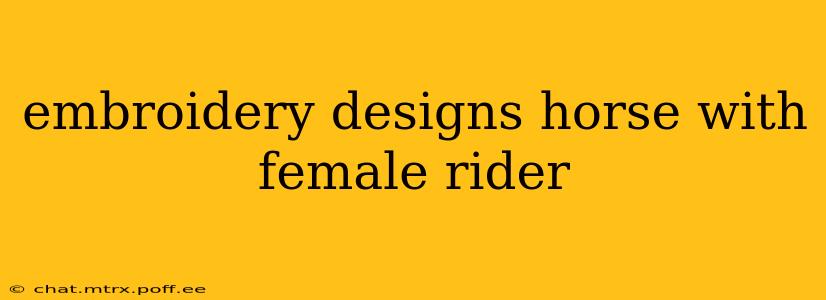Embroidery designs featuring horses and female riders offer a captivating blend of elegance, power, and artistry. Whether you're a seasoned embroiderer or a beginner looking for inspiration, this guide explores various design styles, techniques, and considerations for creating stunning horse and rider embroidery pieces. We'll delve into different approaches, addressing common questions and providing tips to help you achieve exceptional results.
What are some popular styles for horse and rider embroidery designs?
The styles for horse and rider embroidery are as diverse as the embroidery techniques themselves. Popular styles include:
-
Realistic: These designs strive for photographic accuracy, capturing the details of the horse's musculature, the rider's attire, and the overall scene with meticulous precision. They often require advanced embroidery skills and a keen eye for detail.
-
Impressionistic: These designs prioritize the feeling and mood of the scene over strict realism. They utilize loose stitches and varied textures to evoke a sense of movement and emotion.
-
Cartoonish/Whimsical: Perfect for adding a playful touch, these designs simplify the horse and rider into charming and stylized forms. They're often characterized by bold outlines, bright colors, and simplified details.
-
Folk Art: Inspired by traditional folk art styles, these designs incorporate characteristic patterns, color palettes, and stitching techniques specific to a particular region or culture.
Where can I find embroidery patterns for horses and female riders?
Numerous resources offer embroidery patterns for horses and female riders, catering to different skill levels and styles:
-
Online marketplaces: Websites like Etsy and others host a vast selection of digital embroidery patterns created by independent designers. You can find designs ranging from simple line drawings to intricate, multi-layered artworks.
-
Embroidery magazines and books: Publications dedicated to embroidery often feature patterns and tutorials for horse and rider designs. These offer a blend of traditional and modern designs, often with detailed instructions.
-
Digital pattern design software: If you're proficient in digital design, you can create your own custom patterns using software like Adobe Illustrator or specialized embroidery design software.
-
Free online resources: Several websites and blogs offer free embroidery patterns, providing a great starting point for beginners. However, these free patterns may have less detail or complexity compared to paid options.
What kind of thread is best for horse and rider embroidery?
The choice of thread depends on the desired effect and the complexity of the design:
-
Cotton embroidery floss: A classic and versatile choice, cotton floss is readily available in a wide range of colors and is suitable for various embroidery techniques.
-
Silk embroidery floss: Offers a beautiful sheen and subtle color variations, ideal for adding elegance and sophistication to a design.
-
Rayon embroidery floss: A more lustrous option compared to cotton, rayon threads are often used for adding highlights and details.
-
Metallic embroidery threads: Can add a touch of sparkle and luxury, particularly for highlighting certain elements like a bridle or saddle.
What stitches are commonly used in horse and rider embroidery?
Several stitches are well-suited for creating horse and rider embroidery designs, each offering unique characteristics:
-
Satin stitch: Ideal for filling large areas with solid color, creating smooth surfaces for the horse's coat or the rider's clothing.
-
Backstitch: Useful for creating sharp outlines and details, like the horse's mane or the rider's facial features.
-
French knots: Excellent for adding texture and dimension, particularly for creating details such as the horse's eyes or the stitching on the saddle.
-
Chain stitch: Creates a flowing line, perfect for depicting the horse's mane or tail.
How difficult is it to embroider a horse and rider design?
The difficulty level varies greatly depending on the complexity of the design and the embroiderer's skill level. Simple line drawings can be a good starting point for beginners, while highly detailed realistic designs require considerable experience and patience. Starting with a smaller, less complex design is recommended for beginners.
Are there any tips for beginners wanting to embroider a horse and rider?
For beginners embarking on their horse and rider embroidery project:
-
Start with a simple pattern: Choose a design with minimal detail and fewer color changes to avoid feeling overwhelmed.
-
Use a hoop: Using an embroidery hoop will keep the fabric taut, ensuring even stitches and preventing puckering.
-
Practice your stitches: Familiarize yourself with basic embroidery stitches before starting the project.
-
Take your time: Embroidery is a process that requires patience and attention to detail. Don't rush it!
-
Don't be afraid to experiment: Try different colors and stitch combinations to find what works best for you.
Embroidery is a rewarding art form, and creating a horse and rider design can be a particularly fulfilling experience. By carefully selecting your pattern, thread, and stitches, and by taking your time, you can create a beautiful and unique piece of embroidered art.
